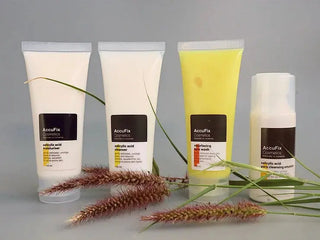In an earlier post on how to build a skincare routine from scratch, I discussed four key steps that make up any routine. These include three core steps - cleansing, moisturising and protection with SPF - and one supplementary step - treating specific skin concerns with active ingredients. I also recommended limiting the treatment step to at most three active ingredients where one - which should also be the first one you add - should be a chemical exfoliant. These wonderful ingredients have a lot to offer to almost everyone after they’ve hit puberty.
In part 1 of this series I covered what exfoliation is and how it benefits the skin, while in part 2 I defined the two major categories of exfoliation and the ingredients available to us in each category. If you haven’t yet read those, you can read them here and here. In this part I’m going to cover how to incorporate exfoliation into your skincare routine for maximum benefit. I’m going to start with general recommendations and end with detailed guidance for anyone looking to incorporate one of the exfoliants in our range into their skincare routine. I’ll also summarise our product related guidelines for you in a table at the end to make all the information easier for you to process.
At present, we have four products that contain chemical exfoliants: our Salicylic Acid Cleanser, Resurfacing Face Wash, Salicylic Acid Pore Cleansing Emulsion and Salicylic Acid Moisturiser. The first two products in this list are exfoliating cleansers and combine two skincare steps in one. And yes, as you’ve probably guessed, we love salicylic acid. Given our strong relationship with acne, we’re huge believers in its skin-clearing powers.

As you read what follows, bear in mind that there is no one size fits all formula. While you’re welcome to start with my recommendations as is, it might take some hit and trial to find the perfect exfoliation routine for you.
General Recommendations
Physical Exfoliation
As I’ve previously mentioned, I’m not a huge fan of physical exfoliation. Chemical exfoliation has a lot more to offer and given the huge range of available exfoliating chemicals in different product formats available, it’s usually easy enough to find a product that works well for you, even if your skin is sensitive. However, if you do opt for physical exfoliation, the process of doing it is simple enough. Here’s how.
Choose a product that has soft scrubbing particles or scrubbing particles with smooth edges. Depending on the consistency of the product, apply it on wet to damp skin and then massage it in small circles using low pressure. Resist the temptation to scrub too hard and to keep scrubbing for an extended period of time. Also try to not go over the same area more than five times. Start by using a scrub twice a week and slowly work your way up but don’t do more than your skin can tolerate - this threshold varies from person to person. Overdoing it will compromise your skin barrier and result in skin dehydration. It will result also result in skin thinning, redness, sensitivity and irritation - all symptoms that no one wants.
Chemical Exfoliation
-
If you’re new to chemical exfoliation, start slowly with a product that has a low concentration of acids and then work your way up.
-
Some initial tingling that lasts for a few minutes after you apply the product is normal, especially if you’re new to acids.
-
If you’re using a mild leave-on exfoliant, starting by using it twice a week is a good idea. If it’s a mild wash off one, you might even be able to use it 3-4 times per week without irritating your skin.
-
Err on the side of caution when starting to exfoliate as despite the numerous benefits that exfoliation has to offer, overdoing it can have some unpleasant side effects.
-
Always moisturise after you exfoliate to maintain a strong skin barrier. If your skin feels sensitive, tight or dry the next day, take a break from exfoliation till it recovers and then cut back on either the frequency with which you exfoliate or on the strength of the exfoliant that you’re using.
-
You can use more than one exfoliant in your routine, but introduce them one at a time and avoid using them at the same time to avoid any unwanted reaction.
-
While all skin types can benefit from exfoliation, it’s always a good idea to patch test products, especially if you’ve experienced product allergies in the past or have overly sensitive skin.
-
Exfoliating makes your skin more sensitive to the sun so don’t forget to
-
wear broad spectrum SPF daily.
Incorporating Exfoliants From Our Range - Recommendations By Skin Type
Sensitive Skin
Ageing Skin | Pigmentation-Prone Skin | Dry, Dehydrated Skin
Oily Skin | Acne Prone Skin
Fungal Acne Prone Skin
And that’s it! Here are links to the mentioned exfoliants and a table that summarises some key points for you. If you’re still confused, or have questions, feel free to reach out to us and our team will be more than happy to help! :)



